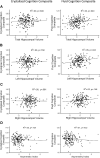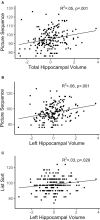Contributions of Hippocampal Volume to Cognition in Healthy Older Adults
- PMID: 33250765
- PMCID: PMC7674177
- DOI: 10.3389/fnagi.2020.593833
Contributions of Hippocampal Volume to Cognition in Healthy Older Adults
Abstract
Objective: The association between hippocampal volume and memory is continuing to be characterized in healthy older adults. Prior research suggests smaller hippocampal volume in healthy older adults is associated with poorer episodic memory and processing speed, as well as working memory, verbal learning, and executive functioning as measured by the NIH Toolbox Fluid (Fluid Cognition Composite, FCC) and Crystalized Cognition Composites (CCC). This study aimed to replicate these findings and to evaluate the association between: (1) hippocampal asymmetry index and cognition; and (2) independent contributions of the left and right hippocampal volume and cognition in a large sample of healthy older adults. Participants and Methods: One-hundred and eighty-three healthy older adults (M age = 71.72, SD = 5.3) received a T1-weighted sequence on a 3T scanner. Hippocampal subfields were extracted using FreeSurfer 6.0 and combined to provide left, right, and total hippocampal volumes. FCC subtests include Dimensional Change Card Sort, Flanker Inhibitory Control and Attention, List Sorting, Picture Sequence Memory, and Pattern Comparison. CCC subtests include Picture Vocabulary and Oral Reading Recognition. Multiple linear regressions were performed predicting cognition composites from the total, left and right, and asymmetry of hippocampal volume, controlling for sex, education, scanner, and total intracranial volume. Multiple comparisons in primary analyses were corrected using a false discovery rate (FDR) of p < 0.05. Results: FCC scores were positively associated with total (β = 0.226, FDR q = 0.044) and left (β = 0.257, FDR q = 0.024) hippocampal volume. Within FCC, Picture Sequence Memory scores positively associated with total (β = 0.284, p = 0.001) and left (β = 0.98, p = 0.001) hippocampal volume. List Sorting scores were also positively associated with left hippocampal volume (β = 0.189, p = 0.029). Conclusions: These results confirm previous research suggesting that bilateral hippocampal volume is associated with FCC, namely episodic memory. The present study also suggests the left hippocampal volume may be more broadly associated with both episodic and working memory. Studies should continue to investigate lateralized hippocampal contributions to aging processes to better identify predictors of cognitive decline.
Keywords: NIH toolbox; aging; brain volume; cognition; hippocampus; magnetic resonance imaging.
Copyright © 2020 Hardcastle, O’Shea, Kraft, Albizu, Evangelista, Hausman, Boutzoukas, Van Etten, Bharadwaj, Song, Smith, Porges, Dekosky, Hishaw, Wu, Marsiske, Cohen, Alexander and Woods.
Figures



References
Grants and funding
LinkOut - more resources
Full Text Sources

